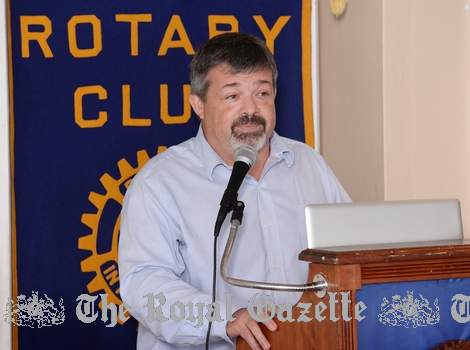All the latest news and updates from the Bermuda Aquarium, Museum & Zoo, one of Bermuda's leading visitor attractions!
Latest News
‘Jewel in crown’ of BZS education efforts
By Owain Johnston-Barnes
Published Sep 30, 2015 at 8:00 am (Updated Sep 30, 2015 at 12:34 am)
Ian Walker, principal curator of the Bermuda Aquarium, Museum and Zoo
(Photograph by Akil Simmons)?
Trunk Island could become the centrepiece of environmental education programmes, according to the Bermuda Zoological Society.
Ian Walker, principal curator of the Bermuda Aquarium Museum and Zoo, told Hamilton Rotary Club yesterday that as cahows returned to Nonsuch Island, Trunk Island could become increasingly important for educational purposes.
“Because Nonsuch has become such a critical habitat for them, we feel that the window is closing,” he said. “It may not be this year or the next, but that bird needs the island now.
“It only takes one invasive species, like the Argentinian ant, and if they get out to the island it would cause absolute havoc for them.”
The BZS inherited a one-third share of one of the island’s two plots several years ago, and recently purchased the second lot with the aim of turning it into a spectacular outdoor classroom.
“Buying an island in this climate is a challenge,” Dr Walker said. “But we believe this is an important aspect of our programmes.
“In fact, we think it’s the jewel in the crown of the BZS education programmes, and it is our living classroom.
“This was a once-in-a-lifetime opportunity and we thought that if we don’t do it now, in ten years we are going to be kicking ourselves.
“Our board was at first a little sceptical, but once you get out to that island, it is a special place. It is a magical place.”

‘Magical place’: An estimated 3,000 students could visit Trunk Island every year,
according to BZS’s Ian Walker (File photograph by Simon Jones)
As well as being close to the Aquarium, allowing the society to easily transport students to and from the island, Dr Walker said the island’s Harrington Sound location could provide a unique educational experience for the estimated 3,000 students who could visit it every year.
He explained that rather than being the mouth of a volcano, as often believed, the sound was a fresh water marsh thousands of years ago before it became flooded with salt water as sea levels rose about 3,000 years ago.
“As a result, it has relatively poor drainage,” he said.
“The main flow is through Flatts bridge and the rest is through caves around the sound itself. As a result there is rich life, specifically planktonic life, which leads to a vast food chain of creatures which take advantage of that.”
Dr Walker said the Society planned to remove non-native plants from the island, replacing them with endemic species, and that David Wingate had expressed excitement about the project, having already gone through the restoration of Nonsuch.
“We are not reinventing the wheel with this,” he said. “We have that level of brainpower and knowledge of Bermuda history that he can say, let’s make this happen, and he’s totally thrilled.”
Meanwhile, education officer Jamie Bacon said that despite the island’s small size, it had a number of different habitats, including an ancient endemic palmetto forest, a sandy beach, a rocky coast, a seagrass bed, and shallow sandy shoals.
“We can teach about habitats, and that’s something that’s consistent from lower primary school to senior school, but we can also teach how organisms adapt to their habitat, about food chains and food webs,” Dr Bacon said.
“We know there are a number of predators out on the island, but we don’t know what they eat, and these are investigations that the students can participate in.
“They can also assist with the implementation of the management plan, which gives them hands-on experience with restoration ecology.
“If they can work with David Wingate, it doesn’t get much better than that.”